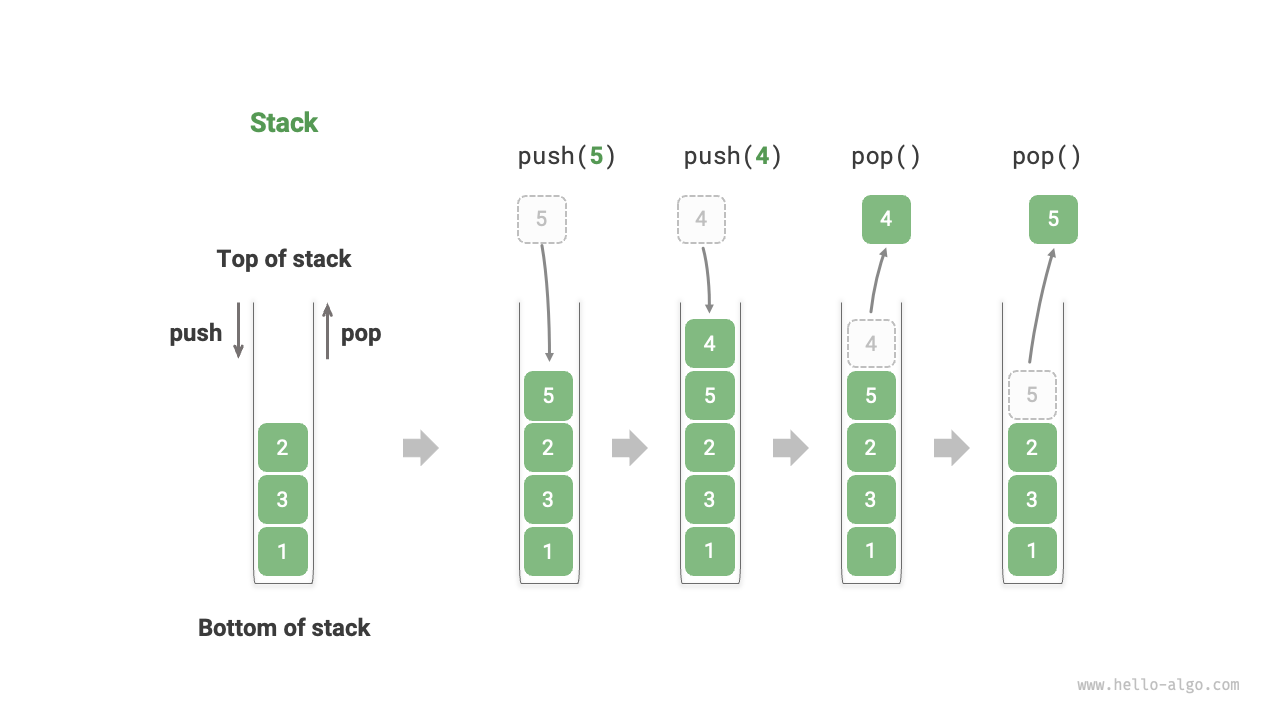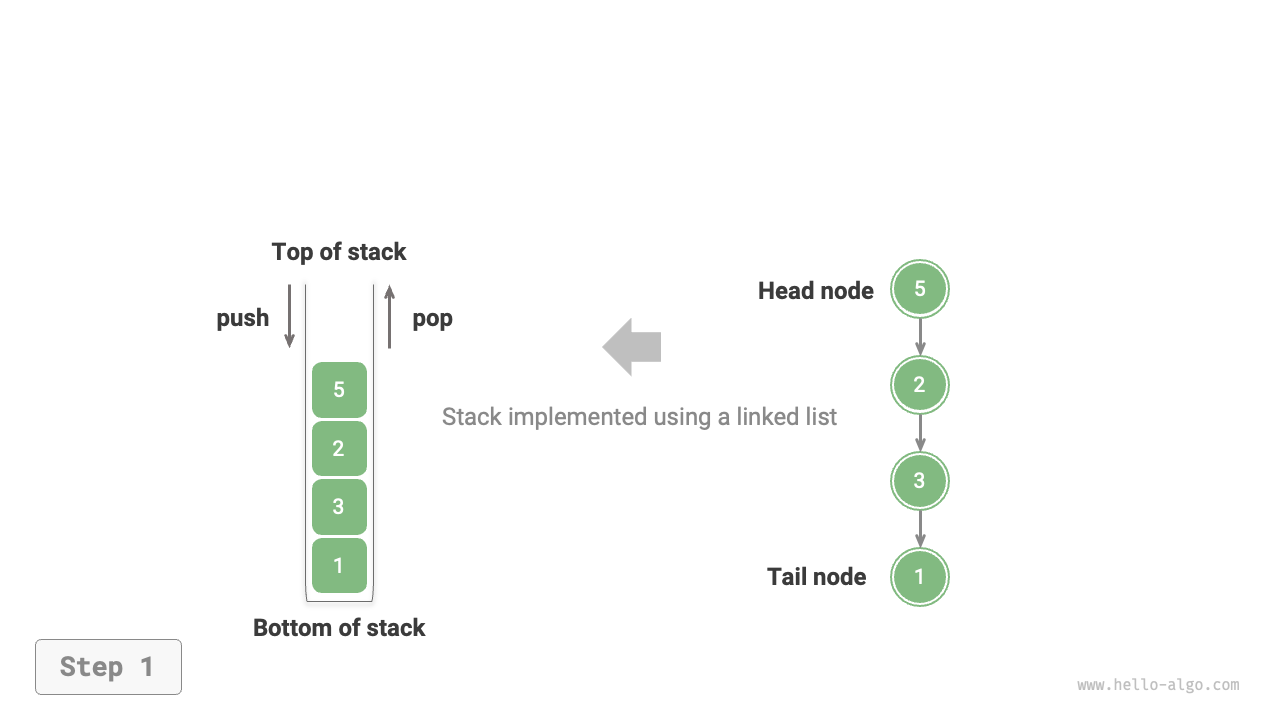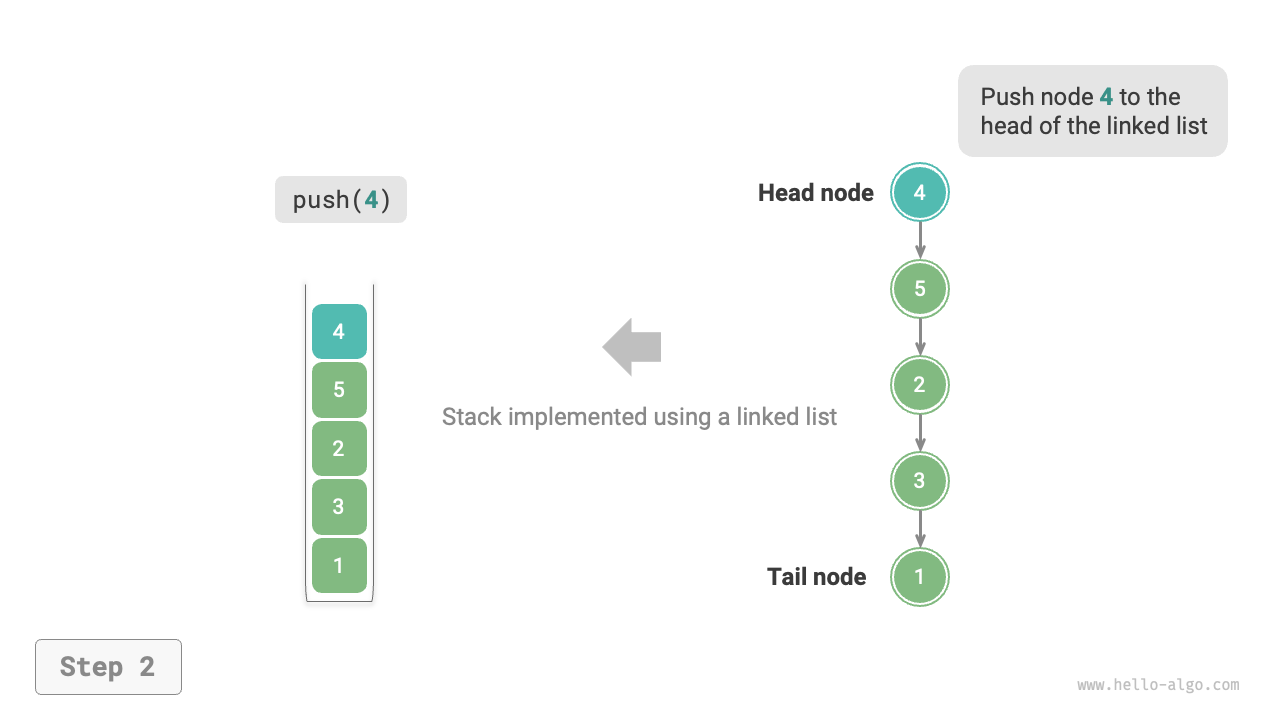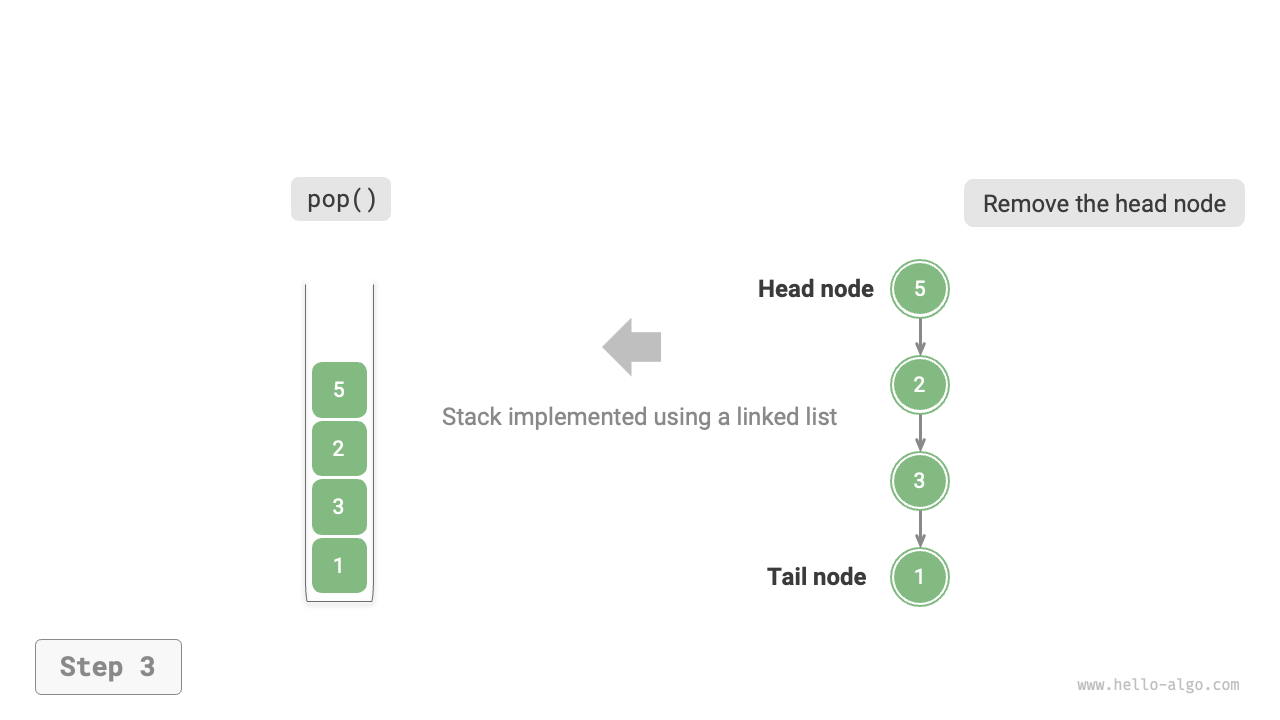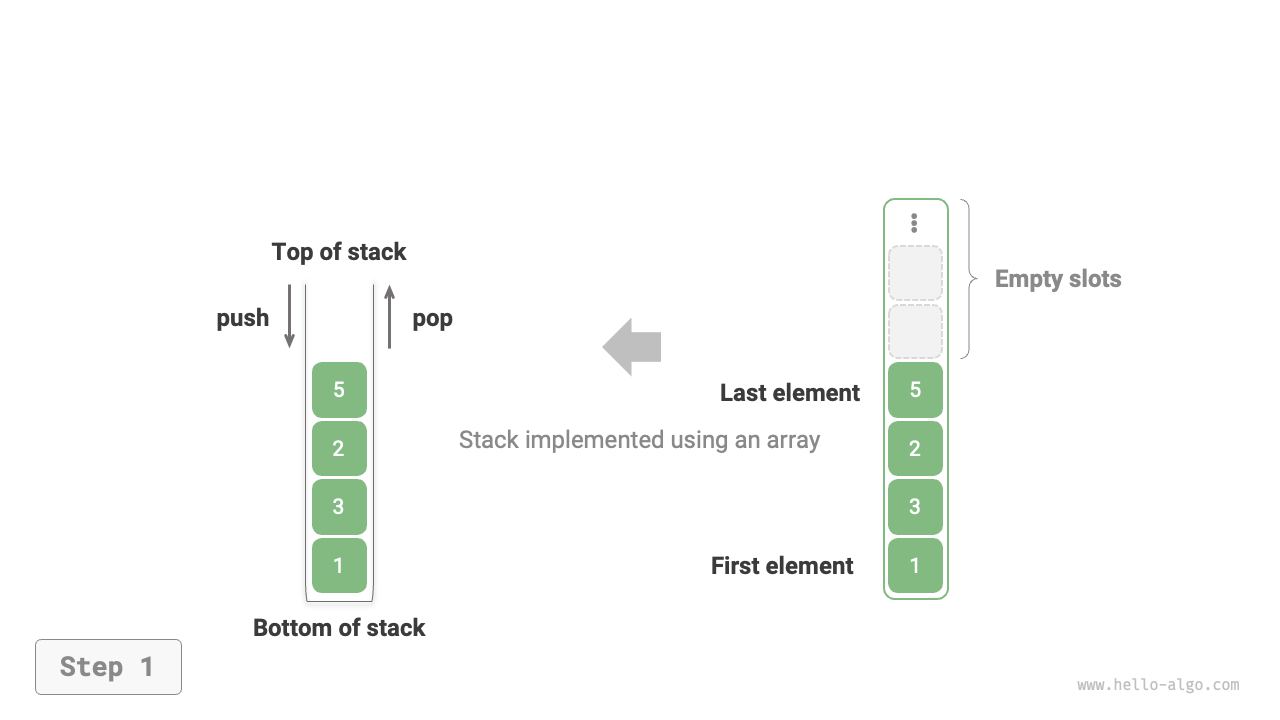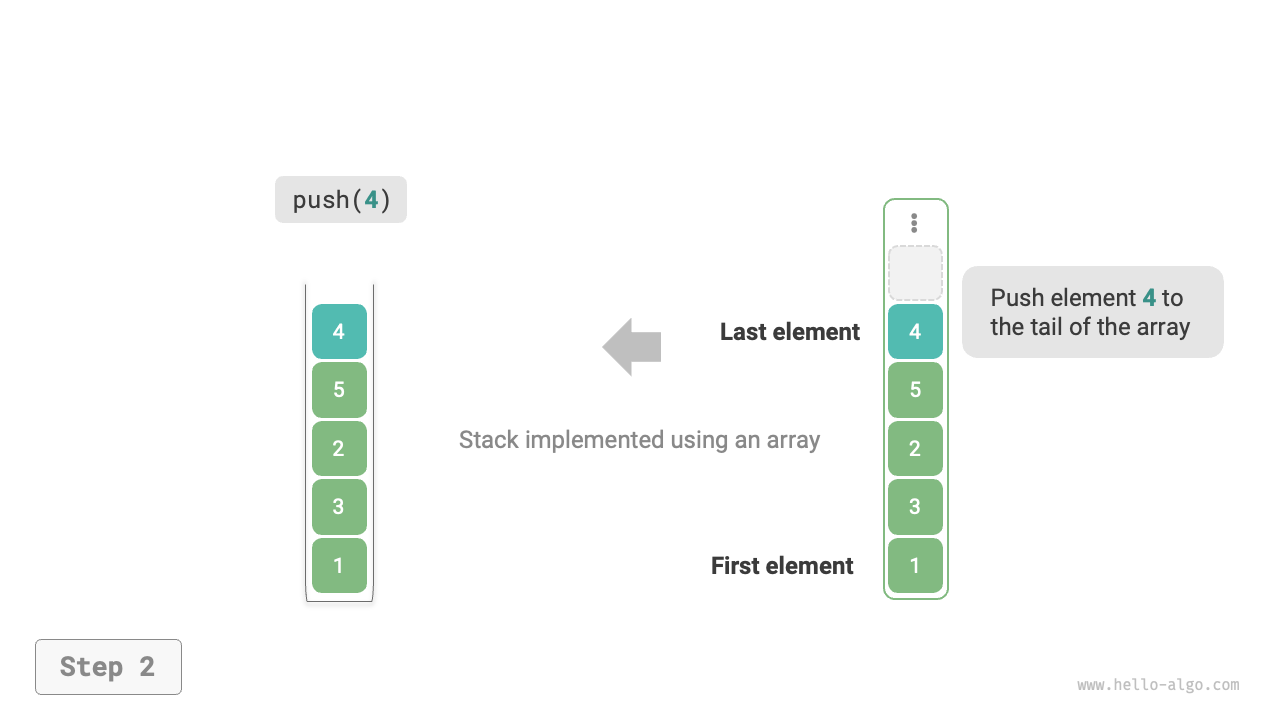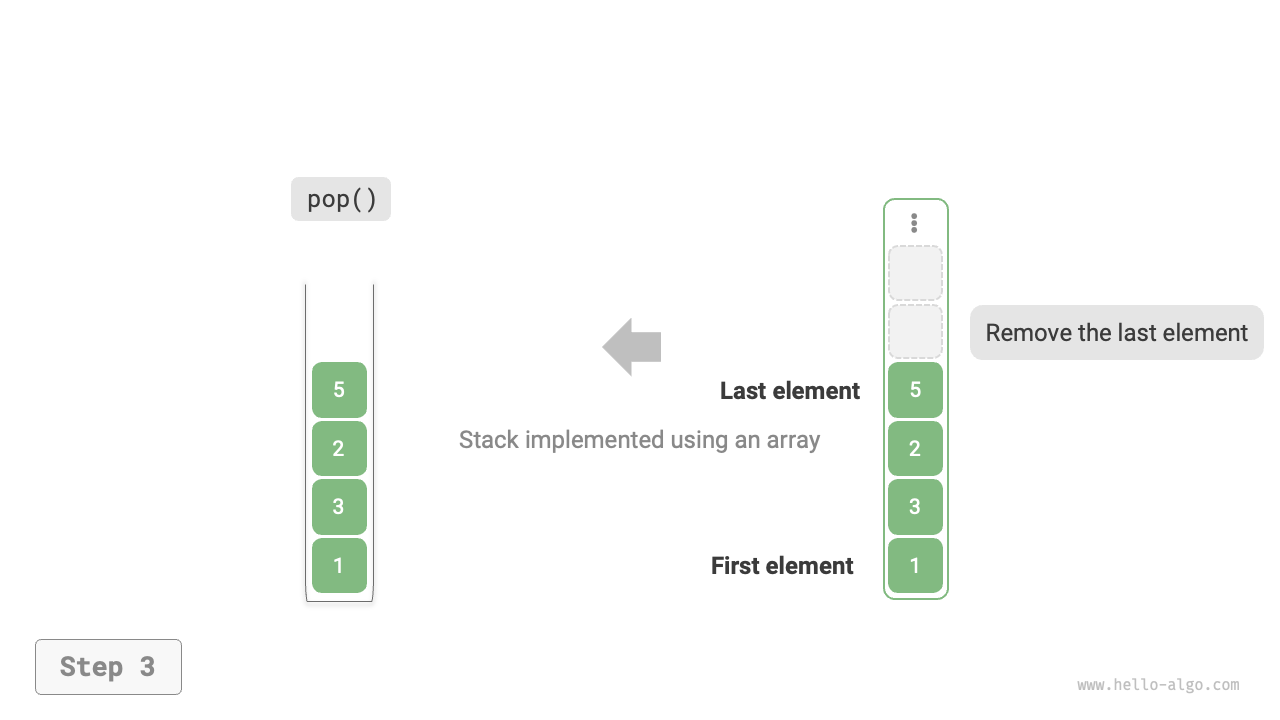5.1 Stack¶
A stack is a linear data structure that follows the principle of Last-In-First-Out (LIFO).
We can compare a stack to a pile of plates on a table. To access the bottom plate, one must first remove the plates on top. By replacing the plates with various types of elements (such as integers, characters, objects, etc.), we obtain the data structure known as a stack.
As shown in Figure 5-1, we refer to the top of the pile of elements as the "top of the stack" and the bottom as the "bottom of the stack." The operation of adding elements to the top of the stack is called "push," and the operation of removing the top element is called "pop."
Figure 5-1 Stack's last-in-first-out rule
5.1.1 Common operations on stack¶
The common operations on a stack are shown in Table 5-1. The specific method names depend on the programming language used. Here, we use push(), pop(), and peek() as examples.
Table 5-1 Efficiency of stack operations
| Method | Description | Time Complexity |
|---|---|---|
push() |
Push an element onto the stack (add to the top) | \(O(1)\) |
pop() |
Pop the top element from the stack | \(O(1)\) |
peek() |
Access the top element of the stack | \(O(1)\) |
Typically, we can directly use the stack class built into the programming language. However, some languages may not specifically provide a stack class. In these cases, we can use the language's "array" or "linked list" as a stack and ignore operations that are not related to stack logic in the program.
# Initialize the stack
# Python does not have a built-in stack class, so a list can be used as a stack
stack: list[int] = []
# Push elements onto the stack
stack.append(1)
stack.append(3)
stack.append(2)
stack.append(5)
stack.append(4)
# Access the top element of the stack
peek: int = stack[-1]
# Pop an element from the stack
pop: int = stack.pop()
# Get the length of the stack
size: int = len(stack)
# Check if the stack is empty
is_empty: bool = len(stack) == 0
/* Initialize the stack */
stack<int> stack;
/* Push elements onto the stack */
stack.push(1);
stack.push(3);
stack.push(2);
stack.push(5);
stack.push(4);
/* Access the top element of the stack */
int top = stack.top();
/* Pop an element from the stack */
stack.pop(); // No return value
/* Get the length of the stack */
int size = stack.size();
/* Check if the stack is empty */
bool empty = stack.empty();
/* Initialize the stack */
Stack<Integer> stack = new Stack<>();
/* Push elements onto the stack */
stack.push(1);
stack.push(3);
stack.push(2);
stack.push(5);
stack.push(4);
/* Access the top element of the stack */
int peek = stack.peek();
/* Pop an element from the stack */
int pop = stack.pop();
/* Get the length of the stack */
int size = stack.size();
/* Check if the stack is empty */
boolean isEmpty = stack.isEmpty();
/* Initialize the stack */
Stack<int> stack = new();
/* Push elements onto the stack */
stack.Push(1);
stack.Push(3);
stack.Push(2);
stack.Push(5);
stack.Push(4);
/* Access the top element of the stack */
int peek = stack.Peek();
/* Pop an element from the stack */
int pop = stack.Pop();
/* Get the length of the stack */
int size = stack.Count;
/* Check if the stack is empty */
bool isEmpty = stack.Count == 0;
/* Initialize the stack */
// In Go, it is recommended to use a Slice as a stack
var stack []int
/* Push elements onto the stack */
stack = append(stack, 1)
stack = append(stack, 3)
stack = append(stack, 2)
stack = append(stack, 5)
stack = append(stack, 4)
/* Access the top element of the stack */
peek := stack[len(stack)-1]
/* Pop an element from the stack */
pop := stack[len(stack)-1]
stack = stack[:len(stack)-1]
/* Get the length of the stack */
size := len(stack)
/* Check if the stack is empty */
isEmpty := len(stack) == 0
/* Initialize the stack */
// Swift does not have a built-in stack class, so Array can be used as a stack
var stack: [Int] = []
/* Push elements onto the stack */
stack.append(1)
stack.append(3)
stack.append(2)
stack.append(5)
stack.append(4)
/* Access the top element of the stack */
let peek = stack.last!
/* Pop an element from the stack */
let pop = stack.removeLast()
/* Get the length of the stack */
let size = stack.count
/* Check if the stack is empty */
let isEmpty = stack.isEmpty
/* Initialize the stack */
// JavaScript does not have a built-in stack class, so Array can be used as a stack
const stack = [];
/* Push elements onto the stack */
stack.push(1);
stack.push(3);
stack.push(2);
stack.push(5);
stack.push(4);
/* Access the top element of the stack */
const peek = stack[stack.length-1];
/* Pop an element from the stack */
const pop = stack.pop();
/* Get the length of the stack */
const size = stack.length;
/* Check if the stack is empty */
const is_empty = stack.length === 0;
/* Initialize the stack */
// TypeScript does not have a built-in stack class, so Array can be used as a stack
const stack: number[] = [];
/* Push elements onto the stack */
stack.push(1);
stack.push(3);
stack.push(2);
stack.push(5);
stack.push(4);
/* Access the top element of the stack */
const peek = stack[stack.length - 1];
/* Pop an element from the stack */
const pop = stack.pop();
/* Get the length of the stack */
const size = stack.length;
/* Check if the stack is empty */
const is_empty = stack.length === 0;
/* Initialize the stack */
// Dart does not have a built-in stack class, so List can be used as a stack
List<int> stack = [];
/* Push elements onto the stack */
stack.add(1);
stack.add(3);
stack.add(2);
stack.add(5);
stack.add(4);
/* Access the top element of the stack */
int peek = stack.last;
/* Pop an element from the stack */
int pop = stack.removeLast();
/* Get the length of the stack */
int size = stack.length;
/* Check if the stack is empty */
bool isEmpty = stack.isEmpty;
/* Initialize the stack */
// Use Vec as a stack
let mut stack: Vec<i32> = Vec::new();
/* Push elements onto the stack */
stack.push(1);
stack.push(3);
stack.push(2);
stack.push(5);
stack.push(4);
/* Access the top element of the stack */
let top = stack.last().unwrap();
/* Pop an element from the stack */
let pop = stack.pop().unwrap();
/* Get the length of the stack */
let size = stack.len();
/* Check if the stack is empty */
let is_empty = stack.is_empty();
Code Visualization
5.1.2 Implementing a stack¶
To gain a deeper understanding of how a stack operates, let's try implementing a stack class ourselves.
A stack follows the principle of Last-In-First-Out, which means we can only add or remove elements at the top of the stack. However, both arrays and linked lists allow adding and removing elements at any position, therefore a stack can be seen as a restricted array or linked list. In other words, we can "shield" certain irrelevant operations of an array or linked list, aligning their external behavior with the characteristics of a stack.
1. Implementation based on a linked list¶
When implementing a stack using a linked list, we can consider the head node of the list as the top of the stack and the tail node as the bottom of the stack.
As shown in Figure 5-2, for the push operation, we simply insert elements at the head of the linked list. This method of node insertion is known as "head insertion." For the pop operation, we just need to remove the head node from the list.
Figure 5-2 Implementing Stack with Linked List for Push and Pop Operations
Below is an example code for implementing a stack based on a linked list:
class LinkedListStack:
"""Stack class based on linked list"""
def __init__(self):
"""Constructor"""
self._peek: ListNode | None = None
self._size: int = 0
def size(self) -> int:
"""Get the length of the stack"""
return self._size
def is_empty(self) -> bool:
"""Determine if the stack is empty"""
return self._size == 0
def push(self, val: int):
"""Push"""
node = ListNode(val)
node.next = self._peek
self._peek = node
self._size += 1
def pop(self) -> int:
"""Pop"""
num = self.peek()
self._peek = self._peek.next
self._size -= 1
return num
def peek(self) -> int:
"""Access stack top element"""
if self.is_empty():
raise IndexError("Stack is empty")
return self._peek.val
def to_list(self) -> list[int]:
"""Convert to a list for printing"""
arr = []
node = self._peek
while node:
arr.append(node.val)
node = node.next
arr.reverse()
return arr
/* Stack class based on linked list */
class LinkedListStack {
private:
ListNode *stackTop; // Use the head node as the top of the stack
int stkSize; // Length of the stack
public:
LinkedListStack() {
stackTop = nullptr;
stkSize = 0;
}
~LinkedListStack() {
// Traverse the linked list, remove nodes, free memory
freeMemoryLinkedList(stackTop);
}
/* Get the length of the stack */
int size() {
return stkSize;
}
/* Determine if the stack is empty */
bool isEmpty() {
return size() == 0;
}
/* Push */
void push(int num) {
ListNode *node = new ListNode(num);
node->next = stackTop;
stackTop = node;
stkSize++;
}
/* Pop */
int pop() {
int num = top();
ListNode *tmp = stackTop;
stackTop = stackTop->next;
// Free memory
delete tmp;
stkSize--;
return num;
}
/* Access stack top element */
int top() {
if (isEmpty())
throw out_of_range("Stack is empty");
return stackTop->val;
}
/* Convert the List to Array and return */
vector<int> toVector() {
ListNode *node = stackTop;
vector<int> res(size());
for (int i = res.size() - 1; i >= 0; i--) {
res[i] = node->val;
node = node->next;
}
return res;
}
};
/* Stack class based on linked list */
class LinkedListStack {
private ListNode stackPeek; // Use the head node as the top of the stack
private int stkSize = 0; // Length of the stack
public LinkedListStack() {
stackPeek = null;
}
/* Get the length of the stack */
public int size() {
return stkSize;
}
/* Determine if the stack is empty */
public boolean isEmpty() {
return size() == 0;
}
/* Push */
public void push(int num) {
ListNode node = new ListNode(num);
node.next = stackPeek;
stackPeek = node;
stkSize++;
}
/* Pop */
public int pop() {
int num = peek();
stackPeek = stackPeek.next;
stkSize--;
return num;
}
/* Access stack top element */
public int peek() {
if (isEmpty())
throw new IndexOutOfBoundsException();
return stackPeek.val;
}
/* Convert the List to Array and return */
public int[] toArray() {
ListNode node = stackPeek;
int[] res = new int[size()];
for (int i = res.length - 1; i >= 0; i--) {
res[i] = node.val;
node = node.next;
}
return res;
}
}
2. Implementation based on an array¶
When implementing a stack using an array, we can consider the end of the array as the top of the stack. As shown in Figure 5-3, push and pop operations correspond to adding and removing elements at the end of the array, respectively, both with a time complexity of \(O(1)\).
Figure 5-3 Implementing Stack with Array for Push and Pop Operations
Since the elements to be pushed onto the stack may continuously increase, we can use a dynamic array, thus avoiding the need to handle array expansion ourselves. Here is an example code:
class ArrayStack:
"""Stack class based on array"""
def __init__(self):
"""Constructor"""
self._stack: list[int] = []
def size(self) -> int:
"""Get the length of the stack"""
return len(self._stack)
def is_empty(self) -> bool:
"""Determine if the stack is empty"""
return self.size() == 0
def push(self, item: int):
"""Push"""
self._stack.append(item)
def pop(self) -> int:
"""Pop"""
if self.is_empty():
raise IndexError("Stack is empty")
return self._stack.pop()
def peek(self) -> int:
"""Access stack top element"""
if self.is_empty():
raise IndexError("Stack is empty")
return self._stack[-1]
def to_list(self) -> list[int]:
"""Return array for printing"""
return self._stack
/* Stack class based on array */
class ArrayStack {
private:
vector<int> stack;
public:
/* Get the length of the stack */
int size() {
return stack.size();
}
/* Determine if the stack is empty */
bool isEmpty() {
return stack.size() == 0;
}
/* Push */
void push(int num) {
stack.push_back(num);
}
/* Pop */
int pop() {
int num = top();
stack.pop_back();
return num;
}
/* Access stack top element */
int top() {
if (isEmpty())
throw out_of_range("Stack is empty");
return stack.back();
}
/* Return Vector */
vector<int> toVector() {
return stack;
}
};
/* Stack class based on array */
class ArrayStack {
private ArrayList<Integer> stack;
public ArrayStack() {
// Initialize the list (dynamic array)
stack = new ArrayList<>();
}
/* Get the length of the stack */
public int size() {
return stack.size();
}
/* Determine if the stack is empty */
public boolean isEmpty() {
return size() == 0;
}
/* Push */
public void push(int num) {
stack.add(num);
}
/* Pop */
public int pop() {
if (isEmpty())
throw new IndexOutOfBoundsException();
return stack.remove(size() - 1);
}
/* Access stack top element */
public int peek() {
if (isEmpty())
throw new IndexOutOfBoundsException();
return stack.get(size() - 1);
}
/* Convert the List to Array and return */
public Object[] toArray() {
return stack.toArray();
}
}
5.1.3 Comparison of the two implementations¶
Supported Operations
Both implementations support all the operations defined in a stack. The array implementation additionally supports random access, but this is beyond the scope of a stack definition and is generally not used.
Time Efficiency
In the array-based implementation, both push and pop operations occur in pre-allocated contiguous memory, which has good cache locality and therefore higher efficiency. However, if the push operation exceeds the array capacity, it triggers a resizing mechanism, making the time complexity of that push operation \(O(n)\).
In the linked list implementation, list expansion is very flexible, and there is no efficiency decrease issue as in array expansion. However, the push operation requires initializing a node object and modifying pointers, so its efficiency is relatively lower. If the elements being pushed are already node objects, then the initialization step can be skipped, improving efficiency.
Thus, when the elements for push and pop operations are basic data types like int or double, we can draw the following conclusions:
- The array-based stack implementation's efficiency decreases during expansion, but since expansion is a low-frequency operation, its average efficiency is higher.
- The linked list-based stack implementation provides more stable efficiency performance.
Space Efficiency
When initializing a list, the system allocates an "initial capacity," which might exceed the actual need; moreover, the expansion mechanism usually increases capacity by a specific factor (like doubling), which may also exceed the actual need. Therefore, the array-based stack might waste some space.
However, since linked list nodes require extra space for storing pointers, the space occupied by linked list nodes is relatively larger.
In summary, we cannot simply determine which implementation is more memory-efficient. It requires analysis based on specific circumstances.
5.1.4 Typical applications of stack¶
- Back and forward in browsers, undo and redo in software. Every time we open a new webpage, the browser pushes the previous page onto the stack, allowing us to go back to the previous page through the back operation, which is essentially a pop operation. To support both back and forward, two stacks are needed to work together.
- Memory management in programs. Each time a function is called, the system adds a stack frame at the top of the stack to record the function's context information. In recursive functions, the downward recursion phase keeps pushing onto the stack, while the upward backtracking phase keeps popping from the stack.
